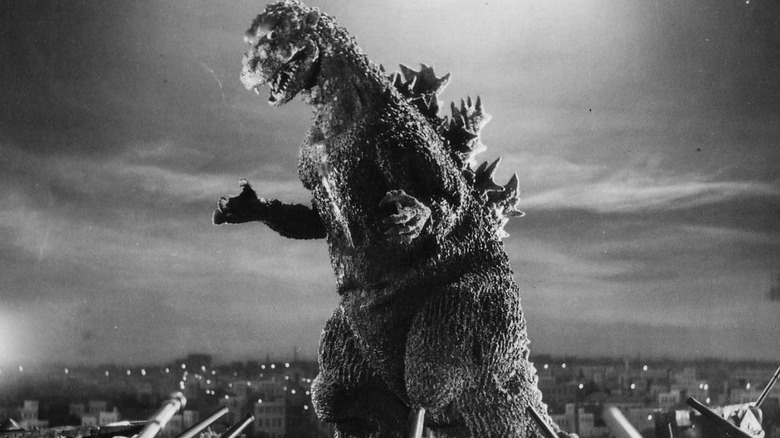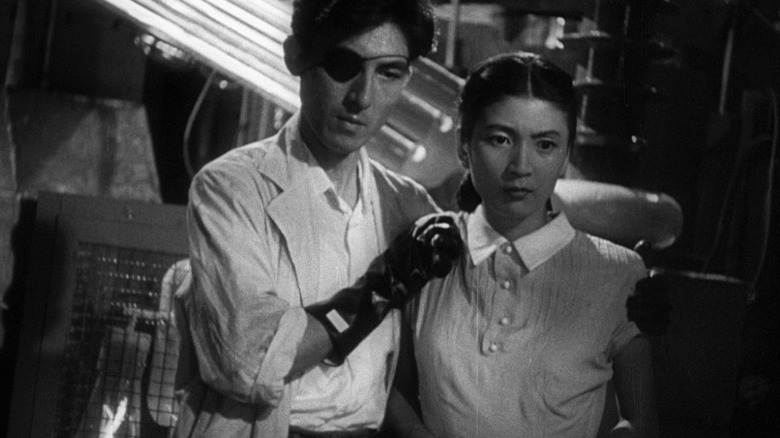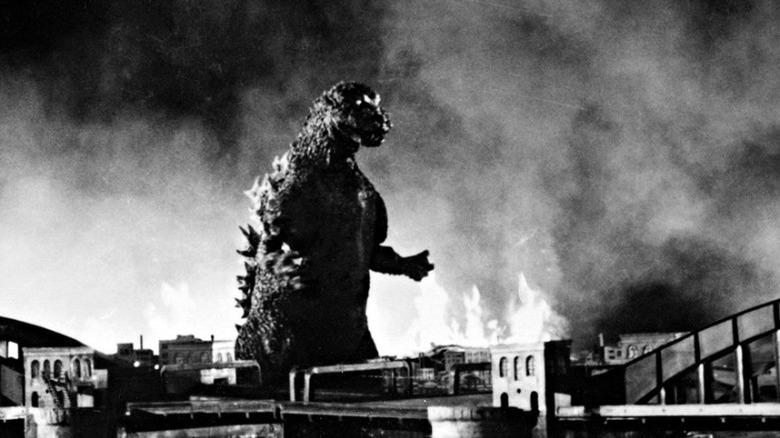The Original Godzilla Film Could Have Ended The Careers Of Everyone Involved
Ishirō Honda's 1954 kaiju film "Godzilla" became a cult phenomenon that eventually birthed the ever-expanding "Godzilla" franchise, which is still a significant part of Japanese pop culture. Although Honda's original is very much a spectacle with a prehistoric monster at the center of the tale, the film is also intensely melancholic, as it reflects the socio-political situation in Japan at the time. As Japan was still recovering from the aftermath of the nuclear attacks on Hiroshima and Nagasaki, the shots of a radioactive beast terrorizing the streets of Tokyo in "Godzilla" deeply resonated with audiences.
The fact that Honda's "Godzilla" spawned more than 30 sequels is a testament to its influence on popular culture, and one would assume that the film's cult hit status was a given at the time of release. This, however, was not the case. "Godzilla" was conceived during a time of great uncertainty in the film industry, during which Honda and his team were threatened with doom if the film were to be a critical and commercial failure. In fact, so much depended on the success of "Godzilla," that Honda gave his team an ultimatum. Due to the risky nature of the endeavor, Honda asked his team to read the script and leave the project immediately if they were not convinced.
There were solid reasons behind Honda's super-serious approach to making "Godzilla," a film that would've put everyone's careers at risk in case it bombed. While that did not (thankfully) occur, let's look into the nitty-gritties of the making of Honda's "Godzilla."
A high-risk, high-reward project
When Honda was preparing to take on "Godzilla," it was the kind of film never made before in Japanese cinema. Apart from being an overly expensive affair due to its special and suitmation effects, "Godzilla" was an ambitious project with a rather ridiculous premise. Postwar Japanese cinema by the likes of Nagisa Oshima and Akira Kurosawa were generally artistic, somber period pieces with nuanced social commentary, but "Godzilla" was mainstream in its appeal, and its serious themes were interspersed with shots of a kaiju defying human defense and destroying anything in its path.
Due to these concerns, Honda understood the importance of taking "Godzilla" seriously from the get-go. The film's production house, Toho, originally intended for Senkichi Taniguchi to spearhead the project, but the director declined the offer, most probably due to its risky nature. After Honda came on board, he demanded the utmost dedication to the project from his team — a fair demand, as he was aware that everyone's careers hinged on the success of "Godzilla." If the film were to flop, Honda and his team would have to deal with the loss of the humongous production cost of $275,000, which would have understandably derailed their careers.
Intense attention to detail was exercised after the project took off, as Honda supervised the construction of miniature sets and worked closely with special effects director Eiji Tsuburaya, who was a pioneer in his field. Honda also carefully crafted the tone of the film, which was a mixture of creature feature and disaster flick, with sci-fi and horror themes embedded into the narrative. Thankfully, all of these efforts paid off.
Why Honda's Godzilla is such a cultural milestone
Honda's directorial debut was a romantic tragedy titled "Blue Pearl," which he followed up with several postwar dramas such as "Eagle of the Pacific." Over the years, Honda worked closely with Tsuburaya, which eventually helped him bag "Godzilla" after Taniguchi declined. After Honda and his "Godzilla" team beat all the odds stacked against them, the film received global recognition and was marketed in the U.S. as "Godzilla, King of Monsters!," which was a heavily edited Americanized version of the original.
This led to the glorious kaiju-era monster films in Japan, which adopted Tsuburaya's suitmation technique to create smoother transitions during high-octane sequences. Honda became synonymous with the creature of a pop culture phenomenon, which in turn influenced the mega-monster and disaster genres, especially within the blockbuster mold. After directing a bunch of dramas and comedies, Honda returned to his field of expertise with the likes of "Battle in Outer Space" and "Mothra vs. Godzilla."
By this time, the kaiju genre had caught on with mainstream audiences, leading to several installments with Godzilla at the center. The franchise expanded with time, leading to video games such as "Shadow of the Colossus" and the "Ultraman" series, while television programs also banked on this genre. The rest is history: An audacious, kaiju-centered artistic endeavor managed to kickstart a pop-culture sensation and change the face of giant monster films forever.


